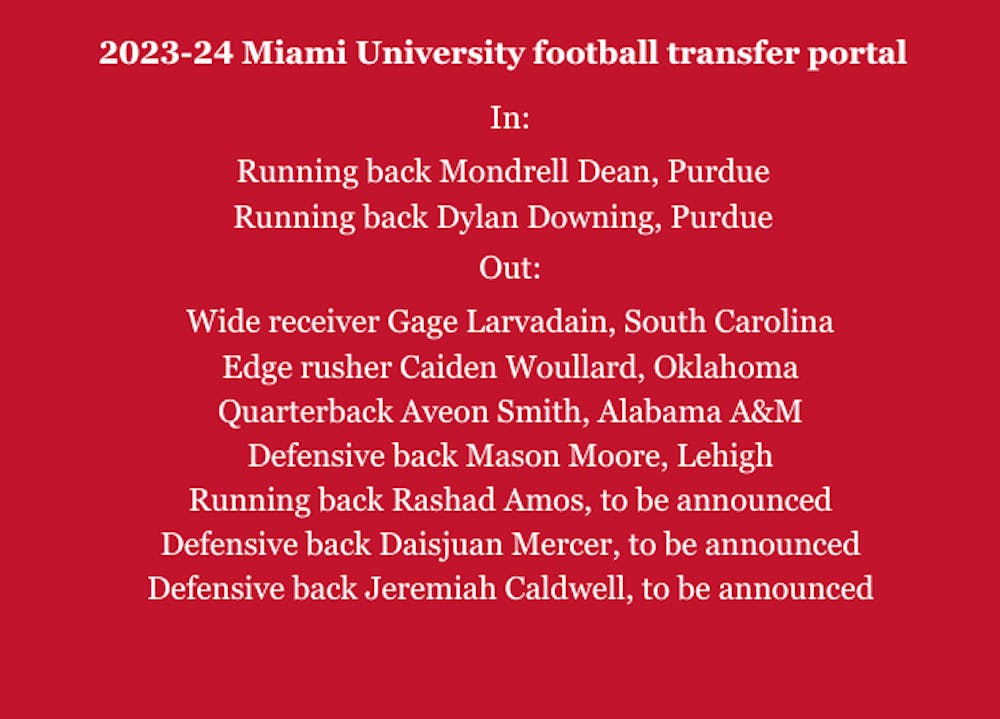Coming into the offseason, the Miami University RedHawks looked like it had a serious chance to contend for a Mid-American Conference (MAC) championship in 2024, as well as a potential berth in the new 12-team college football playoff.
However, on Dec. 23, star running back Rashad Amos and wide receiver Gage Larvadain, two of the best players Miami had on offense, opted to enter the transfer portal for the second time in their careers. Larvadain has since announced his commitment to the University of South Carolina, while Amos is still looking for a place to play. Miami also lost sack leader Caiden Woullard to the transfer portal. The first-time transfer will play for the University of Oklahoma Sooners in 2024.
The 2023 season for Miami football saw many transfers making big impacts. About three quarters of players on Miami’s roster were non-transfer players, but often it was the transfers who made big plays.
It started Week 2 against the University of Massachusetts-Amherst. Larvadain, who transferred from Southeastern Louisiana University, would end the day with 273 yards, just 10 yards short of Jack Sorenson’s school receiving record. In the second quarter, he caught a 99+ yard pass from quarterback Brett Gabbert, the longest play in school history.
During that game, Michael Dowell, a Michigan State University transfer, snagged an interception to hold off a late Massachusetts rally. Looking back, it seems like foreshadowing.
Contributions didn’t just come from Larvadain or Dowell. Mercer University transfer Yahsyn McKee made two of the biggest plays in school history to cement his legacy in the next game against the University of Cincinnati, which Miami hadn’t beaten since 2005 before this season. McKee blocked a potential game-winning 35-yard field goal attempt against the Bearcats as time expired in regulation, and then intercepted quarterback Emory Jones’s overtime pass to win the game for the RedHawks.
There are many more words to be written about the contributions of transfer players, like 1,000-yard rusher Amos or the second-leading sacker Brian Ugwu, a Rutgers University transfer.
The transfer portal has done a lot for the Miami football program in the last few years, but it has also done damage, with mixed results for the players involved. Before the 2023 season, Miami lost three top players to the transfer portal. Rusty Feth, an offensive lineman, transferred to the University of Iowa, where he was an honorable mention all-Big Ten player. Fellow offensive lineman Caleb Shaffer decided to transfer to the University of Oklahoma, where he only started one game in his only season for the Sooners. Cornerback John Saunders Jr. transferred to the University of Mississippi, where he was second-team all-SEC as a safety in 2023.
The creation of the transfer portal in 2018 was a first step in the liberalization of athlete movement and freedom. In July 2021, the National Collegiate Athletic Association (NCAA) began to allow athletes to profit off their names, images and likenesses (NIL), furthering the movement.
After entering the transfer portal, a player is allowed to return to his original team at any time, should his coach allow him to do so. That has allowed the RedHawks to retain players such as the Lou Groza award-winning kicker Graham Nicholson this year and Gabbert last year.
Plenty of key players still plan on returning to Miami for the 2024 season, such as Gabbert, Nicholson, the 2023 MAC Defensive Player of the Year Matt Salopek and much of the offensive line.
And as of the conclusion of Miami’s 2023 season with the Cure Bowl on Dec. 16, Miami fans felt that, despite the disappointing 9-13 loss to Appalachian State University in a monsoon, there was hope for a team that looked to return as many as 18 of the 22 starters.
Enjoy what you're reading?
Signup for our newsletter
Prior to that game, on Dec. 13, Judge John Preston Bailey of West Virginia ruled that two-time transfers were now allowed to play immediately. Before this, the NCAA had required second-time transfers to sit out a year before playing at their new school. On Dec. 22, the NCAA released a memo that allowed the players who had transferred once (like Amos and Larvadain, who entered the portal on Dec. 23) to transfer again without penalty.




